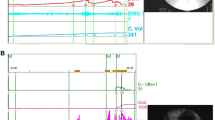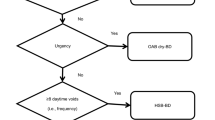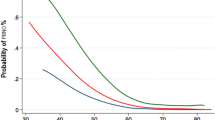Abstract
Bladder-outlet obstruction (BOO) in women has become an increasingly recognized entity over the past several years. This is partly because of the greater number of anti-incontinence surgeries being performed, which can infrequently result in iatrogenic obstruction; and partly because of improvements in the ability to diagnose and recognize BOO. In this review, the symptoms associated with BOO in women, and whether these symptoms can reliably predict the presence of BOO, will be discussed. The incidence of BOO following surgical anti-incontinence procedures and the urodynamic diagnosis of BOO in women, detailing the various criteria that have been proposed, are also reviewed.
Key Points
-
Bladder-outlet obstruction (BOO) in women is an increasingly recognized clinical entity in urology practices
-
Symptoms of BOO in women can be quite varied; while the most common complaint might be difficulty in voiding, the absence of this symptom does not rule out BOO
-
Although various criteria have been proposed to define BOO in women, none are universally accepted; most focus on combined pressure–flow criteria (differing from values in men), with or without fluoroscopic evidence of obstruction
-
Postsurgical BOO seems to be less common with tension-free anti-incontinence procedures, with overall less dramatic changes in pressure–flow values than have been noted following conventional sling procedures; it has not yet been unequivocally demonstrated if transobturator procedures are less obstructive than retropubic synthetic-sling procedures
This is a preview of subscription content, access via your institution
Access options
Subscribe to this journal
Receive 12 print issues and online access
$209.00 per year
only $17.42 per issue
Buy this article
- Purchase on Springer Link
- Instant access to full article PDF
Prices may be subject to local taxes which are calculated during checkout


Similar content being viewed by others
References
Carlson KV et al. (2000) Value of routine evaluation of the voiding phase when performing urodynamic testing in women with lower urinary tract symptoms. J Urol 164: 1614–1618
Rosenblum N et al. (2004) Voiding dysfunction in young, nulliparous women: symptoms and urodynamic findings. Int Urogynecol J Pelvic Floor Dysfunct 15: 373–377
Groutz A et al. (2000) The significance of the American Urological Association symptom index score in the evaluation of women with bladder outlet obstruction. J Urol 163: 207–211
Lemack GE and Zimmern PE (1999) Predictability of urodynamic findings based on the Urogenital Distress Inventory Questionnaire. Urology 54: 461–466
Dietz HP and Haylen BT (2005) Symptoms of voiding dysfunction: what do they really mean? Int Urogynecol J Pelvic Floor Dysfunct 15: 52–55
Constantine E et al. (2003) Uroflowmetry in female voiding disturbances. Neurourol Urodyn 22: 569–573
Al-Shahrani M and Lovatsis D (2005) Do subjective symptoms of obstructive voiding correlate with post-void residual urine volume in women? Int Urogynecol J Pelvic Floor Dysfunct 16: 12–14
Dunn JS et al. (2004) Voiding dysfunction after surgery for stress incontinence: literature review and survey results. Int Urogynecol J Pelvic Floor Dysfunct 15: 25–31
Maher C et al. (1999) The Burch colposuspension for recurrent stress incontinence following retropubic continence surgery. Br J Obstet Gynaecol 106: 719–724
Alcalay M et al. (1995) Burch colposuspension: a 10–20 year follow-up. Br J Obstet Gynaecol 102: 740–745
Klutke JJ et al. (1999) Bladder neck suspension for stress urinary incontinence: how does it work. Neurourol Urodyn 18: 623–627
Lukacz ES et al. (2004) The effects of the tension-free vaginal tape on voiding function: a prospective evaluation. Int Urogynecol J Pelvic Floor Dysfunct 15: 32–38
Ward K and Hilton P (2002) Prospective multicentre randomised trial of tension free vaginal tape and colposuspension as primary treatment for stress incontinence. BMJ 325: 67–70
Leach GE et al. (1987) Mechanism of continence after modified Pereyra bladder neck suspension. Prospective urodynamic study. Urology 29: 328–331
Fulford SC et al. (1999) An assessment of the surgical outcome and urodynamic effects of the pubovaginal sling for stress incontinence and the associated urge syndrome. J Urol 162: 135–137
Belair G et al. (1997) Retropubic cystourethropexy: is it an obstructive procedure? J Urol 158: 533–538
Lin L-Y et al. (2004) Sequential assessment of urodynamic findings before and after tension-free vaginal tape (TVT) operation for female genuine stress incontinence. Eur Urol 45: 362–366
Mellier G et al. (2004) Suburethral tape via the obturator route: is the TOT a simplification of the TVT? Int Urogynecol J Pelvic Floor Dysfunct 15: 227–232
Amundsen CL et al. (2000) Variations in strategy for the treatment of urethral obstruction after a pubovaginal sling procedure. J Urol 164: 434–437
Massey JA and Abrams PH (1988) Obstructed voiding in the female. Br J Urol 61: 36–39
Axelrod SL and Blaivas JG (1987) Bladder neck obstruction in women. J Urol 137: 497–499
Bass JS and Leach GE (1991) Bladder outlet obstruction in women. Probl Urol 5: 141–145
Chassagne S et al. (1998) Proposed cutoff values to define bladder outlet obstruction in women. Urology 51: 408–411
Lemack GE and Zimmern PE (2000) Pressure-flow analysis can aid in identifying women with outflow obstruction. J Urol 163: 1823–1828
Defreitas GA et al. (2004) Refining the diagnosis of anatomic female bladder outlet obstruction: a comparison of pressure-flow study parameters in clinically obstructed women to those of normal controls. Urology 64: 675–681
Nitti VW et al. (1999) Diagnosing bladder outlet obstruction in women. J Urol 161: 1535–1540
Groutz A et al. (2000) Bladder outlet obstruction in women: definition and characteristics. Neurourol Urodyn 19: 213–220
Blaivas JG and Groutz A (2000) Bladder outlet obstruction nomogram for women with lower urinary tract symptomatology. Neurourol Urodyn 19: 553–564
Cormier L et al. (2002) Diagnosis of female bladder outlet obstruction and relevance of the parameter area under the curve of detrusor pressure during voiding: preliminary results. J Urol 167: 2083–2087
Cross CA et al. (1998) Transvaginal urethrolysis for urethral obstruction after anti-incontinence surgery. J Urol 159: 1199–1201
Nitti VW and Raz S (1994) Obstruction following anti-incontinence procedures: diagnosis and treatment with transvaginal urethrolysis. J Urol 152: 93–97
Petrou SP et al. (1999) Suprameatal transvaginal urethrolysis. J Urol 161: 1268–1271
Nitti VW et al. (2002) Early results of pubovaginal sling lysis by midline sling incision. Urology 59: 47–52
Goldman HB et al. (1999) The efficacy of urethrolysis without resuspension for iatrogenic urethral obstruction. J Urol 161: 196–199
Amundsen CL et al. (2000) Variations in strategy for the treatment of urethral obstruction after a pubovaginal sling procedure. J Urol 164: 434–437
Carr LK and Webster GD (1997) Voiding dysfunction following incontinence surgery: diagnosis and treatment with retropubic or vaginal urethrolysis. J Urol 157: 831–823
Author information
Authors and Affiliations
Corresponding author
Ethics declarations
Competing interests
The author declares no competing financial interests.
Rights and permissions
About this article
Cite this article
Lemack, G. Urodynamic assessment of bladder-outlet obstruction in women. Nat Rev Urol 3, 38–44 (2006). https://doi.org/10.1038/ncpuro0378
Received:
Accepted:
Issue Date:
DOI: https://doi.org/10.1038/ncpuro0378
This article is cited by
-
Female Voiding Dysfunction: a Practical Approach to Diagnosis and Treatment
Current Obstetrics and Gynecology Reports (2018)
-
International prostate symptom score for assessing lower urinary tract dysfunction in women
International Urogynecology Journal (2013)
-
Anterior colporrhaphy does not induce bladder outlet obstruction
International Urogynecology Journal (2012)
-
Evaluation and Management of Outlet Obstruction in Women Without Anatomical Abnormalities on Physical Exam or Cystoscopy
Current Urology Reports (2012)
-
Efficacy and safety of combined therapy with tamsulosin and tolterodine in female patients with a maximal flow rate less than 12 ml/s
International Urogynecology Journal (2011)



